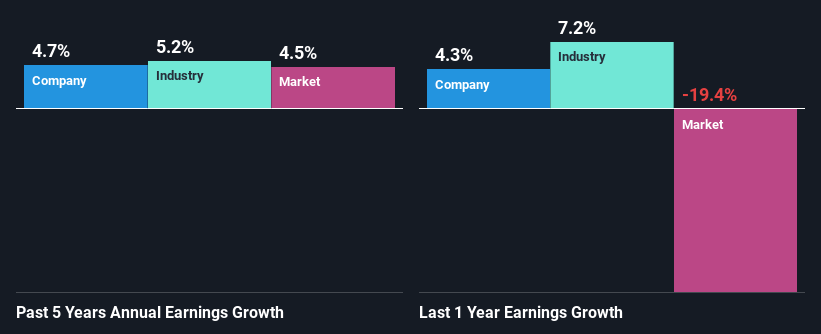Is Fisher & Paykel Healthcare Corporation Limited's (NZSE:FPH) Recent Stock Performance Influenced By Its Fundamentals In Any Way?
Fisher & Paykel Healthcare's (NZSE:FPH) stock is up by a considerable 18% over the past three months. We wonder if and what role the company's financials play in that price change as a company's long-term fundamentals usually dictate market outcomes. Particularly, we will be paying attention to Fisher & Paykel Healthcare's ROE today.
ROE or return on equity is a useful tool to assess how effectively a company can generate returns on the investment it received from its shareholders. In simpler terms, it measures the profitability of a company in relation to shareholder's equity.
See our latest analysis for Fisher & Paykel Healthcare
How To Calculate Return On Equity?
The formula for return on equity is:
Return on Equity = Net Profit (from continuing operations) ÷ Shareholders' Equity
So, based on the above formula, the ROE for Fisher & Paykel Healthcare is:
15% = NZ$262m ÷ NZ$1.8b (Based on the trailing twelve months to September 2023).
The 'return' is the profit over the last twelve months. That means that for every NZ$1 worth of shareholders' equity, the company generated NZ$0.15 in profit.
What Is The Relationship Between ROE And Earnings Growth?
We have already established that ROE serves as an efficient profit-generating gauge for a company's future earnings. Based on how much of its profits the company chooses to reinvest or "retain", we are then able to evaluate a company's future ability to generate profits. Assuming everything else remains unchanged, the higher the ROE and profit retention, the higher the growth rate of a company compared to companies that don't necessarily bear these characteristics.
Fisher & Paykel Healthcare's Earnings Growth And 15% ROE
To start with, Fisher & Paykel Healthcare's ROE looks acceptable. Especially when compared to the industry average of 8.3% the company's ROE looks pretty impressive. However, for some reason, the higher returns aren't reflected in Fisher & Paykel Healthcare's meagre five year net income growth average of 4.7%. This is generally not the case as when a company has a high rate of return it should usually also have a high earnings growth rate. We reckon that a low growth, when returns are quite high could be the result of certain circumstances like low earnings retention or poor allocation of capital.
As a next step, we compared Fisher & Paykel Healthcare's net income growth with the industry and found that the company has a similar growth figure when compared with the industry average growth rate of 5.2% in the same period.
The basis for attaching value to a company is, to a great extent, tied to its earnings growth. It’s important for an investor to know whether the market has priced in the company's expected earnings growth (or decline). Doing so will help them establish if the stock's future looks promising or ominous. One good indicator of expected earnings growth is the P/E ratio which determines the price the market is willing to pay for a stock based on its earnings prospects. So, you may want to check if Fisher & Paykel Healthcare is trading on a high P/E or a low P/E, relative to its industry.
Is Fisher & Paykel Healthcare Using Its Retained Earnings Effectively?
Fisher & Paykel Healthcare has a three-year median payout ratio of 60% (implying that it keeps only 40% of its profits), meaning that it pays out most of its profits to shareholders as dividends, and as a result, the company has seen low earnings growth.
In addition, Fisher & Paykel Healthcare has been paying dividends over a period of at least ten years suggesting that keeping up dividend payments is way more important to the management even if it comes at the cost of business growth. Based on the latest analysts' estimates, we found that the company's future payout ratio over the next three years is expected to hold steady at 63%. Still, forecasts suggest that Fisher & Paykel Healthcare's future ROE will rise to 22% even though the the company's payout ratio is not expected to change by much.
Conclusion
Overall, we feel that Fisher & Paykel Healthcare certainly does have some positive factors to consider. Its earnings growth is decent, and the high ROE does contribute to that growth. However, investors could have benefitted even more from the high ROE, had the company been reinvesting more of its earnings. With that said, the latest industry analyst forecasts reveal that the company's earnings are expected to accelerate. To know more about the company's future earnings growth forecasts take a look at this free report on analyst forecasts for the company to find out more.
Have feedback on this article? Concerned about the content? Get in touch with us directly. Alternatively, email editorial-team (at) simplywallst.com.
This article by Simply Wall St is general in nature. We provide commentary based on historical data and analyst forecasts only using an unbiased methodology and our articles are not intended to be financial advice. It does not constitute a recommendation to buy or sell any stock, and does not take account of your objectives, or your financial situation. We aim to bring you long-term focused analysis driven by fundamental data. Note that our analysis may not factor in the latest price-sensitive company announcements or qualitative material. Simply Wall St has no position in any stocks mentioned.

 Yahoo Finance
Yahoo Finance 
